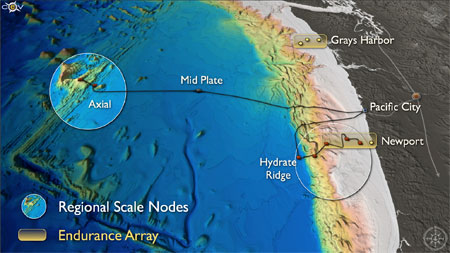Bringing High Power and Bandwidth Into the Oceans:
The Ocean Observatories Initiative
By:
Dr. Deborah S. Kelley
University of Washington
When: |
Friday, January 22, 2010, 10:30 a.m. to 11:30 a.m. |
Where: |
Seminar Conference Room, 10100 Burnet Road, Bldg 196-ROC, Austin, Texas 78758 |
Host: |
Gail Christeson, UTIG |
Abstract
The National Science Foundation has committed ~$700 million over 6 years for construction and early operation of the Ocean Observatories Initiative. This novel infrastructure, with a design life of 25 years, will forever transform how oceanography is conducted and the science that can be addressed. In addition to making much needed high latitude and coastal measurements, supported by relatively low bandwidth satellite communications systems, one of the most transformative pieces of this initiative will be the electro-optically submarine cabled observing systems implemented off the coast of Washington and Oregon. This system, the first of many cabled observing networks, will create a large aperture 'natural laboratory' for conducting a wide

range of long-term, innovative experiments within the ocean using real-time control over the entire laboratory system (http://www.interactiveoceans.washington.edu/). More than 800 km of submarine cable will deliver 10ís of kilowatts of power to seafloor nodes that provide power and 10 Gigabit/sec connectivity between land and arrays of sensors and platforms on the seafloor and throughout the water column. Networked arrays of seafloor sensors will be focused on processes associated with earthquakes, seafloor volcanism, and hydrothermal vents and gas hydrate deposits with their associated biological communities. In addition, state-of-the-art full-water column moorings will include instrumented profilers and winches that allow real-time investigation of climate change, ocean acidification and biogeochemical processes in an area of coastal upwelling and high productivity. The infrastructure will be adaptable, expandable, and exportable and will empower creativity within a broad spectrum of investigators for incorporation of next-generation sensors, robotic and autonomous vehicles, and other novel platforms. The University of Washington is leading the installation and operation of the cabled component of the NSF Initiative, known as the Regional Scale Nodes. The data policy calls for all information to be made available to all interested users via the Internet (with the exception of information bearing on National Security).




